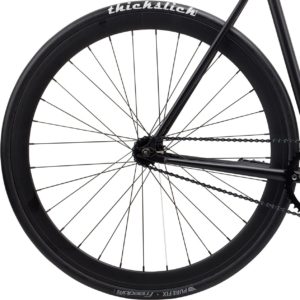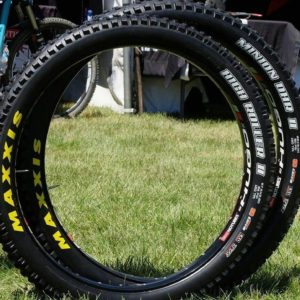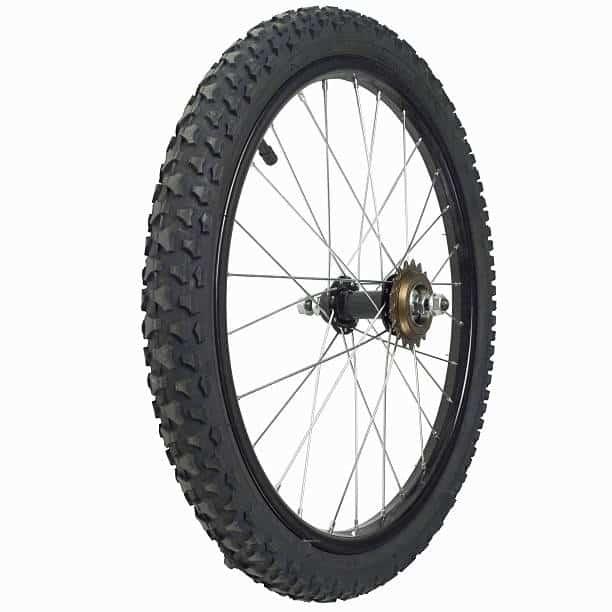Many people dont realize the importance of matching your riding style to the right MTB wheel size. Doing so will not only help your riding, but it can also save you money on the road.
MTB wheels are often referred to by their size, measured by their diameter in inches. The original standard for mountain bikes was 26″. This standard was established many years ago and has not changed until recently due to technological advances. The first new wheel size to hit the market was 29″ wheels. The 29″ mountain bike wheels, often referred to as 29ers, are the same rim diameter as the standard 700c you may be familiar with from road bikes. More recently, the 27.5″ mid-size wheel was created and has become increasingly popular. The 27.5″ standard came from European touring bikes and European tandem bikes. It then moved into very small womens/childrens road bikes before becoming popular in mountain bikes. You may also see that this size is called 650b. Regardless of the origin of these wheel sizes, there are pros and cons to switching to a larger or smaller wheel size.
Table of Contents
Pros of smaller MTB wheels
Strength
 A smaller MTB wheel will be much stronger than a larger wheel. This is why you dont see many downhills and freeride mountain bikes with a 29″ wheel size. This is because the longer spoke design creates less tension and, therefore, less strength. Larger wheels also tend to be more flexible. The flexibility of a larger wheel shouldnt be an issue unless youre racing downhill or freeride. This is because rim, spoke, and hub designs have improved dramatically over the past 10 years. The recent development of the Boost 148 is an excellent example of how big wheels are getting stiffer. Research shows that big wheels will stand up to most mountain bikers.
A smaller MTB wheel will be much stronger than a larger wheel. This is why you dont see many downhills and freeride mountain bikes with a 29″ wheel size. This is because the longer spoke design creates less tension and, therefore, less strength. Larger wheels also tend to be more flexible. The flexibility of a larger wheel shouldnt be an issue unless youre racing downhill or freeride. This is because rim, spoke, and hub designs have improved dramatically over the past 10 years. The recent development of the Boost 148 is an excellent example of how big wheels are getting stiffer. Research shows that big wheels will stand up to most mountain bikers.
Better cornering mechanics
Most mountain bikers agree that a smaller bike wheel allows for better cornering in several ways. Smaller wheels require less arm movement to produce the lean angle for cornering. The gyroscopic effect of the wheel is also less because smaller wheels are generally lighter. Larger diameter wheels can provide more traction and speed, but a decrease in agility and lean angle can be considered a drawback on a winding trail. Finally, cornering at higher speeds can easily throw off a larger wheel due to its increased flexibility.
Acceleration
Smaller MTB wheels, holding all other factors constant, will pick up speed faster than a larger wheel. Tight, winding trails that require you to pedal out of corners will favor a smaller wheel that picks up speed faster.
Pros of larger MTB wheels
Footprint
 With a larger MTB wheel, you also get a larger footprint. This means that when the tire is on the ground, there is more rubber surface in contact. Anything that is facilitated by better traction, such as braking, cornering, and technical climbing, is easier with a larger footprint. This doesnt mean that larger wheels are better for technical climbing or turning but that youll get more traction than a smaller wheel in these situations.
With a larger MTB wheel, you also get a larger footprint. This means that when the tire is on the ground, there is more rubber surface in contact. Anything that is facilitated by better traction, such as braking, cornering, and technical climbing, is easier with a larger footprint. This doesnt mean that larger wheels are better for technical climbing or turning but that youll get more traction than a smaller wheel in these situations.
Riding on Objects
One of the main arguments in favor of a larger MTB wheel size is that the larger wheel rolls better over an object because of the angle at which the object contacts the wheel. An object will hit higher on a smaller wheel than a larger wheel, creating a more significant impact. You can easily imagine which object would roll better on a speed bump, a longboard, or a monster truck. The longboard will roll over the speed bump successfully but could cause the cyclist to crash at higher speeds, while the monster truck driver probably wouldnt even feel it. The same idea applies to MTB wheels. All else, larger MTB wheels will roll over obstacles and maintain speed over rough terrain better than a smaller wheel.
Other Considerations
Wheels are a significant component of any bike, and wheel size affects many other things you may not think about.
Frames
Bikes with larger wheels generally have longer chainstays, wheelbase, and standing heights than bikes with smaller wheels. Engineers have to increase frame geometry because of the larger wheel size. If youre under 57″ and you go to a bike store looking for a 29er, you may not have luck finding one that fits. Bike manufacturers dont always make a small or extra small because the geometry doesnt work. Conversely, bikes with smaller wheels have smaller geometry. Tall men and women can feel very uncomfortable because manufacturers cant make a frame big enough for them.
Suspension
In addition, suspension components must also accommodate larger wheels. The forks and rear shocks need to be longer to accommodate larger wheels. As a result, 29ers have less suspension travel than the 27.5″ and 26″ options. This is another reason why downhill racers and free-riders tend to gravitate toward smaller wheel sizes. Going over a cliff with only 100mm of travel is hard. Full travel 27.5″ downhill bikes have recently emerged thanks to technological advances. You may be able to find a company that makes a 29er with 200mm of travel, but it will only be suitable for a limited number of people.
Mountain Bike Wheel Size For Height
| Height | Wheel Size |
| 29″-31″ or 85-90 cm | 10 inches |
| 31″-33″ or 90-100 cm | 12 inches |
| 33″- 37″ or 100-110 cm | 14 inches |
| 37″- 38″ or 110-115 cm | 16 inches |
| 38″- 40″ or 115-120 cm | 18 inches |
| 40″ -45″ or 120-135 cm | 20 inches |
| 45″ - 49″ or 135-145 cm | 24 inches |
| 5 or 145 cm + | 26 inches |
Conclusion
The bike you choose depends on your preferences as a rider. In general, larger mountain bike wheels are better suited to climbing non-technical terrain and riding straight through rough terrain. Smaller wheels tend to be more agile in turns and have more suspension travel. Youll soon discover that one wheel size isnt necessarily better than the other. Theyre used differently, creating a great reason to buy more bikes!
As with most bike debates, the best way to find out what size is right for you is to go to your nearest bike store or demo day to take a test ride.
